 Carbon-14
dating techniques were first developed by the American chemist, Willard F. Libby
at the University of Chicago in the 50's, for which he received the Nobel Prize
in
Carbon-14
dating techniques were first developed by the American chemist, Willard F. Libby
at the University of Chicago in the 50's, for which he received the Nobel Prize
in
Carbon-14
Sean D. Pitman M.D.
© June 2004
|
Table of Contents
|
|
|
 Carbon-14
dating techniques were first developed by the American chemist, Willard F. Libby
at the University of Chicago in the 50's, for which he received the Nobel Prize
in
Carbon-14
dating techniques were first developed by the American chemist, Willard F. Libby
at the University of Chicago in the 50's, for which he received the Nobel Prize
in
What Is Carbon-14?
To understand this process we must first understand a little bit about the atoms
themselves and how they get their names. Most carbon atoms have six
positively charged protons and six uncharged neutrons. Since protons and
neutrons weigh about the same, the atomic mass of ordinary carbon is 6 + 6 = 12.
It is called "Carbon-12," which is abbreviated "12C." The fact that
the atom has six protons is what makes it carbon. Most nitrogen atoms have seven
protons and seven neutrons, so their atomic mass is 7 + 7 = 14. The fact that it
has seven protons 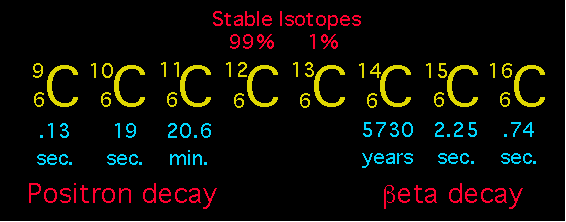 is what makes it nitrogen. Other atoms are also named based on the number
of protons they carry. Notice in the diagram that eight different isotopes
of Carbon are illustrated. Three of the Carbon isotopes (12C,
13C, and 14C) are found in nature. The rest of the carbon
isotopes are only of laboratory interest. To the left side of each C (C is the
symbol for Carbon) are two numbers, the bottom number indicates the Atomic
Number or the number of protons in the nucleus. Since all the atoms are carbon,
they should all have an Atomic Number of 6. The top number is the Mass Number
for each isotope. The Mass Number for any isotope is the addition of all the
protons and neutrons in the nucleus. Looking at the first isotope in the chart,
Carbon 9 has 9 (protons + neutrons). Remember that the Atomic Number (the bottom
number) indicates the number of protons. So simple arithmetic should tell us the
number of neutrons. Carbon 9 has 3 neutrons. Carbon 10 would have 4 neutrons and
Carbon 11 would have 5 neutrons, and so on. What should catch your attention is
the nature of the various carbon isotopes. Only two of the carbon isotopes are
stable (12C and 13C). They constitute essentially 100% of
the carbon in our world, although 12C is obviously much more common
(99%). All the other Carbon Isotopes are unstable and they degrade into
something else. Notice that the farther away the Mass Number gets from 12-13,
the faster they break down (The blue numbers indicate half-lives, the time it
takes for one half of the atoms in a sample to break down.). So the farther the
carbon is from the norm, the more unstable it is. 9C, 10C,
and 11C have too few neutrons so when they breakdown, they release a
positron which effectively turns a proton into a neutron. The opposite occurs
with 14C, 15C, and 16C. They have too many
neutrons so they breakdown, releasing a beta particle which effectively converts
a neutron into a proton. Thus the breakdown of radioactive atoms is a
self-corrective process; those Isotopes which have too many neutrons loose a
neutron in the beta decay, and those Isotopes which have too few neutrons gain a
neutron in the positron decay.
is what makes it nitrogen. Other atoms are also named based on the number
of protons they carry. Notice in the diagram that eight different isotopes
of Carbon are illustrated. Three of the Carbon isotopes (12C,
13C, and 14C) are found in nature. The rest of the carbon
isotopes are only of laboratory interest. To the left side of each C (C is the
symbol for Carbon) are two numbers, the bottom number indicates the Atomic
Number or the number of protons in the nucleus. Since all the atoms are carbon,
they should all have an Atomic Number of 6. The top number is the Mass Number
for each isotope. The Mass Number for any isotope is the addition of all the
protons and neutrons in the nucleus. Looking at the first isotope in the chart,
Carbon 9 has 9 (protons + neutrons). Remember that the Atomic Number (the bottom
number) indicates the number of protons. So simple arithmetic should tell us the
number of neutrons. Carbon 9 has 3 neutrons. Carbon 10 would have 4 neutrons and
Carbon 11 would have 5 neutrons, and so on. What should catch your attention is
the nature of the various carbon isotopes. Only two of the carbon isotopes are
stable (12C and 13C). They constitute essentially 100% of
the carbon in our world, although 12C is obviously much more common
(99%). All the other Carbon Isotopes are unstable and they degrade into
something else. Notice that the farther away the Mass Number gets from 12-13,
the faster they break down (The blue numbers indicate half-lives, the time it
takes for one half of the atoms in a sample to break down.). So the farther the
carbon is from the norm, the more unstable it is. 9C, 10C,
and 11C have too few neutrons so when they breakdown, they release a
positron which effectively turns a proton into a neutron. The opposite occurs
with 14C, 15C, and 16C. They have too many
neutrons so they breakdown, releasing a beta particle which effectively converts
a neutron into a proton. Thus the breakdown of radioactive atoms is a
self-corrective process; those Isotopes which have too many neutrons loose a
neutron in the beta decay, and those Isotopes which have too few neutrons gain a
neutron in the positron decay.
 Looking
specifically at Carbon-14, we see that it is a Beta emitter with a half life of
5730 years. When Carbon-14 emits a beta particle, the Carbon-14 atom becomes a
Nitrogen-14 Atom. Looking at the Mass Number and Atomic Number of the atoms we
see that the atom has lost a neutron and gained a proton. Also you will see that
the Mass and Atomic Numbers in the equation are equal on both sides of the
equation.
Looking
specifically at Carbon-14, we see that it is a Beta emitter with a half life of
5730 years. When Carbon-14 emits a beta particle, the Carbon-14 atom becomes a
Nitrogen-14 Atom. Looking at the Mass Number and Atomic Number of the atoms we
see that the atom has lost a neutron and gained a proton. Also you will see that
the Mass and Atomic Numbers in the equation are equal on both sides of the
equation.
Making Carbon-14
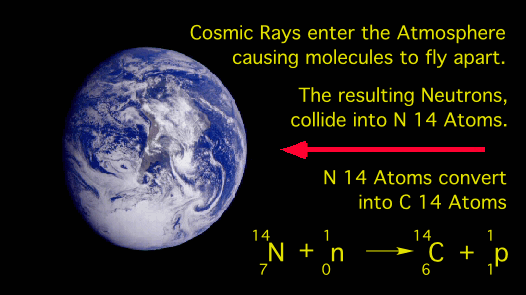 The
atoms that we are particularly interested in are the ones that make up the
earth's atmosphere. These include nitrogen (78 percent), oxygen (21
percent), argon (0.9 percent), carbon dioxide (0.03 percent), varying amounts of
water vapor, and trace amounts of hydrogen, ozone, methane, carbon monoxide,
helium, neon, krypton, and xenon. Cosmic rays, which contain even
higher levels of energy than ultraviolet light, cause some of the atoms in
the upper atmosphere to fly apart into pieces. Neutrons that come from these
fragmented molecules run into other molecules. When a neutron collides into a
Nitrogen-14 atom, the Nitrogen-14 turns into Carbon-14 along with a proton. So
in this reaction, a neutron is captured by the nitrogen atom and a proton is
released. Thus in the nitrogen atom, a proton is effectively converted into a
neutron, which allows a Carbon to be produced. Two other reactions (Oxygen-17
reacting with neutrons, and He-4 reacting with Carbon-13) both produce
Carbon-14, but with much smaller yields. It has been estimated that about 21
pounds of 14C
is produced every year in the upper atmosphere. So in addition to
12C
and 13C, which are both naturally
occurring, 14C is also naturally occurring in
our world. However, unlike both 12C and
13C,
14C is unstable. The only reason why
14C
continues to be found on Earth is because of its continued production in the
upper atmosphere.
The
atoms that we are particularly interested in are the ones that make up the
earth's atmosphere. These include nitrogen (78 percent), oxygen (21
percent), argon (0.9 percent), carbon dioxide (0.03 percent), varying amounts of
water vapor, and trace amounts of hydrogen, ozone, methane, carbon monoxide,
helium, neon, krypton, and xenon. Cosmic rays, which contain even
higher levels of energy than ultraviolet light, cause some of the atoms in
the upper atmosphere to fly apart into pieces. Neutrons that come from these
fragmented molecules run into other molecules. When a neutron collides into a
Nitrogen-14 atom, the Nitrogen-14 turns into Carbon-14 along with a proton. So
in this reaction, a neutron is captured by the nitrogen atom and a proton is
released. Thus in the nitrogen atom, a proton is effectively converted into a
neutron, which allows a Carbon to be produced. Two other reactions (Oxygen-17
reacting with neutrons, and He-4 reacting with Carbon-13) both produce
Carbon-14, but with much smaller yields. It has been estimated that about 21
pounds of 14C
is produced every year in the upper atmosphere. So in addition to
12C
and 13C, which are both naturally
occurring, 14C is also naturally occurring in
our world. However, unlike both 12C and
13C,
14C is unstable. The only reason why
14C
continues to be found on Earth is because of its continued production in the
upper atmosphere.
The amount of nitrogen in the atmosphere is effectively constant. The conversion of a nitrogen atom to a carbon atom does decrease the total number of nitrogen atoms, but it makes about as much difference as removing a teaspoon of water from the Pacific Ocean. Remember, all the carbon in the entire atmosphere makes up less than 0.03% of all the atoms in the atmosphere. Also, 14C is rare compared to the other carbon isotopes, being found in only trace amounts at around 1 part per trillion (0.0000000001%) of the carbon in the atmosphere (Link).
So, if the amount of nitrogen in the atmosphere stays the same, and the amount of cosmic radiation stays the same, 14C will be produced at a steady rate. If the atmosphere started out with absolutely no 14C, there would be a certain amount after one year of exposure of nitrogen to cosmic radiation. After two years, there would be twice as much 14C. This "birth rate" would be constant. But what about the death rate?
Losing Carbon-14
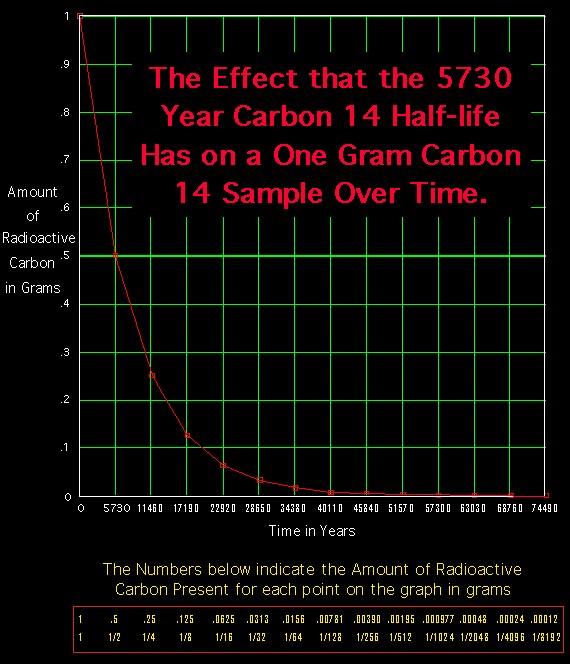 Stable
carbon has six protons and six neutrons. Stable nitrogen has seven protons and
seven neutrons. Stable oxygen has eight protons and eight neutrons. But 14C
is not so well balanced. It has six protons and eight neutrons, which makes it
unstable. Sooner or later, one of the neutrons spits out an electron and becomes
a proton. This gives it seven protons and seven neutrons, which makes it
nitrogen. One cannot predict exactly when a
particular 14C atom will emit an electron and turn into 14N,
but the statistics are very predictable. Given a large number of 14C
atoms, we can say with a high degree of confidence that half of them will turn
into 14N in 5,730 years. This is called the "half-life" because half
of the 14C will disappear in that time. At the end of that time,
half of the remaining 14C will turn into 14N in another
5,730 years (the second half-life). As one would expect, the exponential
curve of radioactive decay does not give accurate results at either extreme of
the curve. It does not work very well on things that died a few hours ago, nor
does it work well on things that died several tens of thousands of years ago.
Let us plug a few numbers in the equations and see why.
Stable
carbon has six protons and six neutrons. Stable nitrogen has seven protons and
seven neutrons. Stable oxygen has eight protons and eight neutrons. But 14C
is not so well balanced. It has six protons and eight neutrons, which makes it
unstable. Sooner or later, one of the neutrons spits out an electron and becomes
a proton. This gives it seven protons and seven neutrons, which makes it
nitrogen. One cannot predict exactly when a
particular 14C atom will emit an electron and turn into 14N,
but the statistics are very predictable. Given a large number of 14C
atoms, we can say with a high degree of confidence that half of them will turn
into 14N in 5,730 years. This is called the "half-life" because half
of the 14C will disappear in that time. At the end of that time,
half of the remaining 14C will turn into 14N in another
5,730 years (the second half-life). As one would expect, the exponential
curve of radioactive decay does not give accurate results at either extreme of
the curve. It does not work very well on things that died a few hours ago, nor
does it work well on things that died several tens of thousands of years ago.
Let us plug a few numbers in the equations and see why.
Using Carbon-14 as a Clock for Dating Organic Material
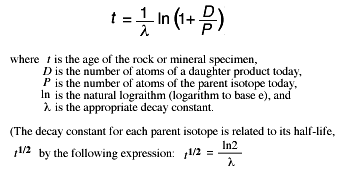 Suppose
we want to use 14C dating to determine when Abraham Lincoln died. We
could dig up his casket and take a sample of the wood from it. If the tree
that made the casket was cut down 135 years ago, the ratio of 14C to
12C in that wood sample divided by the ratio of 14C to 12C
in the air today should be 0.983803. But suppose our equipment for measuring the
ratio is only accurate to 0.1%. Then our measurement could be off by one digit
in the third decimal place. In other words, our measured ratio might be between
0.982803 and 0.984803 because of the limited accuracy of our equipment. Plugging
these two ratios into the equation that converts the 14C ratio into
time the calculation yields a range of dates between 143.4 and 126.6 years ago.
What it boils down to is that a 0.1% error in the measurement produces up to a
6.2% error in the result.
Suppose
we want to use 14C dating to determine when Abraham Lincoln died. We
could dig up his casket and take a sample of the wood from it. If the tree
that made the casket was cut down 135 years ago, the ratio of 14C to
12C in that wood sample divided by the ratio of 14C to 12C
in the air today should be 0.983803. But suppose our equipment for measuring the
ratio is only accurate to 0.1%. Then our measurement could be off by one digit
in the third decimal place. In other words, our measured ratio might be between
0.982803 and 0.984803 because of the limited accuracy of our equipment. Plugging
these two ratios into the equation that converts the 14C ratio into
time the calculation yields a range of dates between 143.4 and 126.6 years ago.
What it boils down to is that a 0.1% error in the measurement produces up to a
6.2% error in the result.
Now, lets try a few other thought experiments and see what happens. Lets try the same experiment on King Tut's coffin. King Tut died in 1,325 BC. So, the wood in his coffin should be about 3,325 years old. The normalized 14C ratio should be 0.668846. But, if the measurement is only accurate to 3 decimal places, it might be between 0.667846 and 0.669846. This would yield dates between 3,312 and 3,337 years old. That is an error of 12 years, but it is only and error of up to 0.4% of the correct value.
The absolute error (12 years) is larger than the absolute error for Abe's casket (8.6 years), but when you are talking about 3,325 years, what is 12 years, more or less? So we see why carbon 14 may work very well for dating things that died a few thousand years ago though not so well for things that died recently.
As might be expected though, the same problems in dating young samples plague the accurate dating of very old samples. When the time since death gets very large, the slope of the radioactive decay curve gets very flat. This results in very large errors. For example, imagine a piece of wood from a tree that was cut down 50,000 years ago. Its normalized 14C ratio should be 0.002362. A 0.1% error in measurement (0.001362 to 0.003362) yields ages ranging between 47,082 and 54,551 years. That is an error of up to 2,918 years on the young side (which is 5.8%) and 4,551 years on the old side (which is +9.1%). Remember that the ratio of 14C to 12C is about 0.6% today. If you multiply 0.6% by 0.002, you are trying to measure the amount of 14C when it is only 0.0012% of the total sample. So, even a small amount of contamination will corrupt the results in a very significant way. That's why 50,000 years is the generally quoted as the practical limit for 14C dating generally mentioned in the scientific literature. Anything thought to be older than 50,000 years is said to have an "infinite" carbon age.
Carbon-14 in Living Things
So, we can see that 14C is very limited for the dating of anything considered to be even close to the supposed ages of lets say, "millions of years". But, what about those creatures that lived less than 50,000 years ago? How do they get 14C inside of themselves and them stop getting 14C inside of themselves when they die?
As long as a plant is alive, it takes carbon dioxide from the air and water from the ground and converts them into sugar. Since about 0.6% of the carbon in the carbon dioxide it breathes is 14C, about 0.6% of the carbon atoms in the sugar it builds will be 14C. Animals eat plants to get the sugar they need to survive. Since 0.6% of the carbon they get from sugar is 14C, about 0.6% of the carbon in their muscles, bones, fat, etc. will be 14C. When a plant or animal dies, no new carbon atoms are acquired. For example, the wooden boards used to make King Tut's coffin are not acquiring any more carbon of any kind today. But the 14C in those boards is slowly decaying into nitrogen (14N). So, when a scientist takes a sample of King Tut's coffin and measures the ratio of 14C to 12C, the ratio will be lower than it was when the wood was alive because about 33% of the 14C atoms in it have turned into 14N. Obviously then, if the original ratio is known and the current ratio is known, the time involved can be easily calculated based on the known half-life of 14C.
Just a Few Potential Problems
"The troubles of the radiocarbon dating method are undeniably deep and serious. Despite 35 years of technological refinement and better understanding, the underlying assumptions have been strongly challenged.... It should be no surprise, then, that fully half of the dates are rejected. The wonder is, surely, that the remaining half comes out to be accepted. There are gross discrepancies, the chronology is uneven and relative, and the accepted dates are actually selected dates."
Robert E. Lee, Anthropological Journal of Canada, Vol. 19, no. 3, 1981, p.9
What happens if the ratio of 14C as compared to 12C in the atmosphere fluctuates over time? If this were to happen, in a significant way, might this not be a very big problem for accurate dating? The assumption we have to make when computing 14C dates is that the ratio of 14C to 12C is essentially the same today as it was when the organic material we are dating died. Certainly this is the assumption that scientists must make, but is this a valid assumption? Is there evidence that may undermine the validity of this assumption?
"Throughout the conference emphasis was placed on the fact that laboratories do not measure ages, they measure sample activities. The connection between activity and age is made through a set of assumptions... one of the main assumptions of C14 dating is that the atmospheric radiocarbon level has held steady over the age range to which the method applies."
Report on 14th Conference, 145 International Scientists, Science, Vol. 150, p. 1490.
One really interesting problem is that the ratio of 14C to 12C is not in equilibrium at all but is increasing fairly rapidly and is known to have fluctuated significantly throughout history - perhaps due to various long term weather changes, huge geologic events, or other catastrophic changes affecting the biosphere. This changing ratio is the reason why carbon 14 dates are not determined by directly looking at the ratio of 14C to 12C. Surprisingly enough, this is not how carbon 14 dating is done at all. What has to be done in order to get "accurate" carbon 14 dates is that the ratio of 14C to 12C must be "calibrated" or compared to the 14C to 12C ratios in organic samples of known historical ages - like King Tut's coffin. So how, exactly, is this calibration done?
Calibrating Carbon-14 Dating
One method of carbon-14 dating calibration involves the use of tree rings. Scientists have counted thousands of tiny tree rings from very long-lived trees called the bristlecone pines. Then, assuming that these trees only produce one ring per year, they determined how old the trees were when they died (In reality a tree may in fact produce several rings or no rings in a given year depending on environmental factors). By correlating the youngest rings with rings of living trees, they determined the year when the trees died and, presumably, knew how long it had been since each tree-ring died. Interestingly enough though, when carbon 14 dating was performed on the oldest rings, the "age" was significantly different when compared to the number of rings.
For example, say that a very old living tree has 2,500 rings. It seems at least reasonable then that this tree is around 2,500 years old and that the innermost rings are the oldest rings - right? Since the innermost rings died 2,500 years ago, the ratio of 14C to 12C detected in these innermost rings, as compared to the current ratio of 14C to 12C in today's atmosphere, should give a very direct "age" of these rings that is very near 2,500 years - right? Wrong! The carbon-14 "age" will not match the tree ring "age" very well at all.
So now what? Well, fudge factors (which are called "calibration" factors) are used to "correct" the carbon 14 date. Is it all starting to sound a little less solid now? Many scientists are fond of claiming that all the various dating methods "agree" with each other. Well, of course they do if they are all "calibrated" so that they have to agree with each other. The fact of the matter is though that even the most reliable dating methods, such as tree ring dating and carbon-14 dating, do not agree with each other in an independent way and must therefore be calibrated with each other in order to make any sense. Of course, the process of calibration itself adds just one more level uncertainty to the date calculation. But, this uncertainty might not be too terribly significant depending upon the reliability of the calibration techniques.
The theory of carbon-14 calibration is relatively straightforward. Naturally occurring materials that exhibit annual growth phenomena (e.g., tree rings, lake and marine varves, etc.) are carbon 14 dated as precisely as possible over age ranges that can (ideally) be dated absolutely via other historical methods. The resulting calibration curve shows the relation between conventional 14C dates and calendar ages, its trends and "wiggles" reflecting the variation of the 14C to 12C ratio in the atmosphere over time. Once generated, the calibration curves (or more accurately, their underlying data sets) enable the conversion of a date in radiocarbon years to a calendar age range or ranges. But, what happens it if turns out that these calibration data sets are significantly in error?
Problems With Tree Ring Dating
and Carbon-14 Calibration
|
|
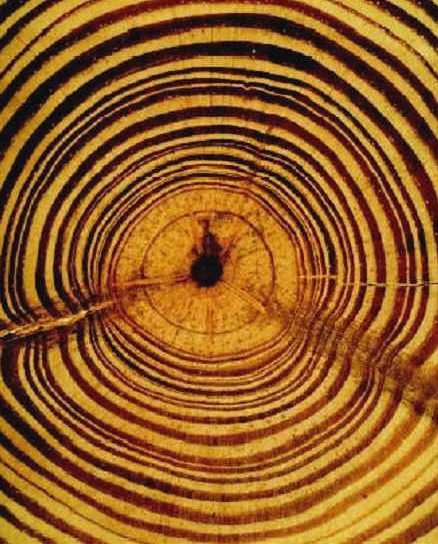
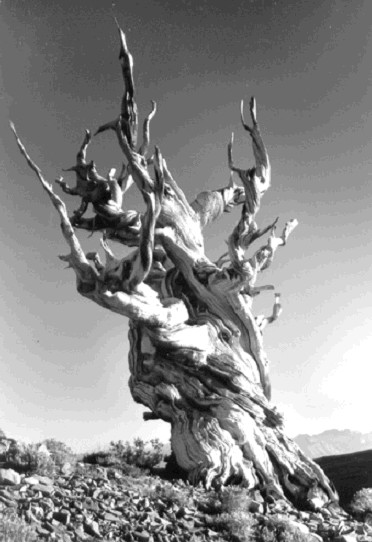 Tree
ring dating is based on a simple and seemingly straightforward notion that every
year a tree forms one ring in the wood that it creates as it grows. All
one has to do to determine the age of the tree, to a fairly good estimate at
least, is count the rings. The first scientist to really start doing this as a
serious means of dating things was Andrew Ellicott Douglass (1867-1962).
Douglass was an American astronomer who is now generally credited with being the
"Father of Dendrochronology". Beginning around 1884 he discovered a
correlation between tree ring patterns and sun spot cycles, but his findings and
conclusions were initially doubted by most scientists of his day. Later Edmund
Schulman (1908-1958), from the University of Arizona, took up the notion of tree
ring dating and in the process made Bristlecone pines famous. Schulman studies
these very old tree for over 30 years (primarily in the White Mountains at
elevations between 9,500 to 11.500 ft).
Tree
ring dating is based on a simple and seemingly straightforward notion that every
year a tree forms one ring in the wood that it creates as it grows. All
one has to do to determine the age of the tree, to a fairly good estimate at
least, is count the rings. The first scientist to really start doing this as a
serious means of dating things was Andrew Ellicott Douglass (1867-1962).
Douglass was an American astronomer who is now generally credited with being the
"Father of Dendrochronology". Beginning around 1884 he discovered a
correlation between tree ring patterns and sun spot cycles, but his findings and
conclusions were initially doubted by most scientists of his day. Later Edmund
Schulman (1908-1958), from the University of Arizona, took up the notion of tree
ring dating and in the process made Bristlecone pines famous. Schulman studies
these very old tree for over 30 years (primarily in the White Mountains at
elevations between 9,500 to 11.500 ft).
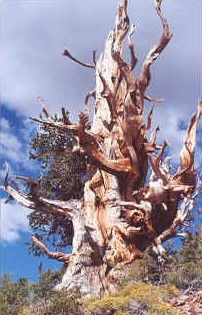 Then
came Charles W. Ferguson. Starting about 1967, with the help of H.C. Fritts,
Ferguson carried on the work of studying Bristlecone pines that was started by
Schulman. It was Ferguson who noticed that the dead wood scattered on the
surrounding slopes did not match the existing ring patterns of the living trees.
This mismatch seemed to create a gap in time between the living and dead wood.
The living trees could be dated as far back as 4,700 years. The Methuselah Tree
is has around 4,767 rings, making it the oldest living tree on Earth (Outside of arguments that some clonal plant colonies, to include some trees, can live much longer. The most extreme example identified is a stand of quaking Aspen (Populus tremuloides) in Utah nicknamed Pando, thought to be 80,000 years old - based on radiocarbon dating of course. As the National Parks Service puts it, "Aspen are so different that it may be better not to think of them as trees. A stand of aspen is really only one huge organism where the main life force is underground"). This
"gap" between the living and the dead wood was first breached by A.E. Douglass
while testing prehistoric beams in the ruins near Show Low, Arizona. After this
gap was breached, Ferguson was eventually able to construct a continuous tree
ring record reaching as far back as 8,680 years before present (B.P.). Then,
during the 1980s, Ferguson was able to extend this continuous sequence back to
about 11,300 years B.P., using radiocarbon dating to help with the validation
process.
Then
came Charles W. Ferguson. Starting about 1967, with the help of H.C. Fritts,
Ferguson carried on the work of studying Bristlecone pines that was started by
Schulman. It was Ferguson who noticed that the dead wood scattered on the
surrounding slopes did not match the existing ring patterns of the living trees.
This mismatch seemed to create a gap in time between the living and dead wood.
The living trees could be dated as far back as 4,700 years. The Methuselah Tree
is has around 4,767 rings, making it the oldest living tree on Earth (Outside of arguments that some clonal plant colonies, to include some trees, can live much longer. The most extreme example identified is a stand of quaking Aspen (Populus tremuloides) in Utah nicknamed Pando, thought to be 80,000 years old - based on radiocarbon dating of course. As the National Parks Service puts it, "Aspen are so different that it may be better not to think of them as trees. A stand of aspen is really only one huge organism where the main life force is underground"). This
"gap" between the living and the dead wood was first breached by A.E. Douglass
while testing prehistoric beams in the ruins near Show Low, Arizona. After this
gap was breached, Ferguson was eventually able to construct a continuous tree
ring record reaching as far back as 8,680 years before present (B.P.). Then,
during the 1980s, Ferguson was able to extend this continuous sequence back to
about 11,300 years B.P., using radiocarbon dating to help with the validation
process.

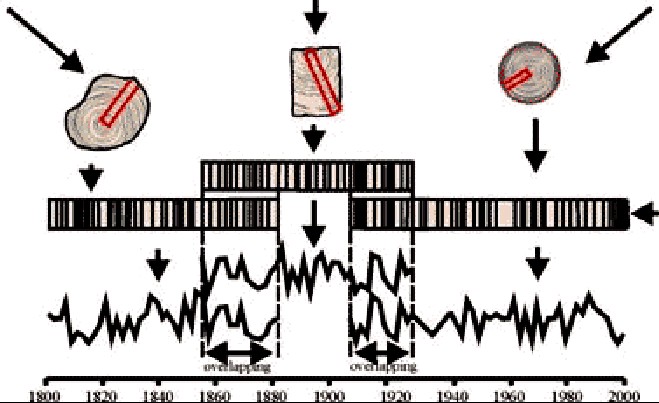
 The
way such gaps are breached is also rather simple and straight forward in theory.
All one has to do is find matches in the pattern of the tree rings found in the
living trees as well as the dead trees. This overlap is used to create a
sequence that links up different pieces of wood to make a longer sequence.
This method is what was used to create the Bristlecone pine sequence.
Similar tree ring chronologies and dates have since been obtained for European
oak and pine tree sequences. Such sequences have also been used to correct
or "calibrate" radiocarbon dates. In this light it is interesting to note that
radiocarbon dates have also been used to calibrate tree ring dates.
The
way such gaps are breached is also rather simple and straight forward in theory.
All one has to do is find matches in the pattern of the tree rings found in the
living trees as well as the dead trees. This overlap is used to create a
sequence that links up different pieces of wood to make a longer sequence.
This method is what was used to create the Bristlecone pine sequence.
Similar tree ring chronologies and dates have since been obtained for European
oak and pine tree sequences. Such sequences have also been used to correct
or "calibrate" radiocarbon dates. In this light it is interesting to note that
radiocarbon dates have also been used to calibrate tree ring dates.
A Few Minor Problems
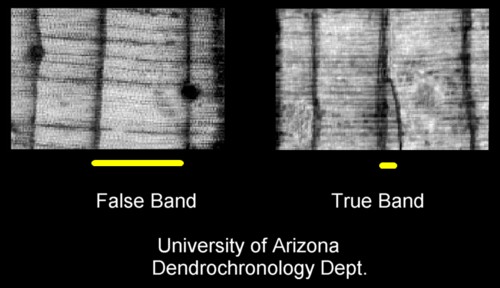
Certain studies have shown that occasionally Bristlecone pines do not produce a ring for a given year and, more commonly, produce an extra ring during some years. Lammerts (1983) found extra rings after studying the development of Bristlecone saplings. He suggested that the existing chronology should be compressed by up to 20% because of this problem alone.23 Publications and online articles from the Dendrochronology Department of the University of Arizona also show that the science of dendrochronology is not all that straightforward. A great deal of subjective interpretation is required to judge between true and false rings and true and false pattern matches between different pieces of wood. For estimating the ages of trees that are still living, this doesn't seem to be a significant problem, but when it comes to matching up wood from different trees, to create an extended overlapping chronology, the problems become a bit more difficult to overcome.
More Difficult Problems
Consider a 1986 paper written by D. K. Yamaguchi.11 In this paper Yamaguchi recognized that tree rings tend to "auto correlate" or actually cross-match with each other in several places within a tree-ring sequence. What he did to prove this was quite interesting. He took a 290-ring Douglas-fir log known, by historical methods, to date between AD 1482 and 1668 and demonstrated that it could cross-match in multiple places with the Pacific Northwest Douglas Fir Master Growth-ring Sequence to give very good t-values. A t-value is given to a wiggle-match on the basis of a statistical analysis of the correspondence between two wood samples. This statistical assessment is done by computer which assigns high t-values (3 and above) to good wiggle-matches and low t-values (below 3) to those with poor correspondence between the ring patterns. Amazingly, using such t-value analysis, Yamaguchi found 113 different matches having a confidence level of greater than 99.9%. For example, Yamaguchi demonstrated that his log could cross-match with other tree-ring sequences to give t-values of around 5 at AD 1504 (for the low end of the ring age), 7 at AD 1647 and 4.5 at AD 1763. Six of these matches were non-overlapping.11 That means that this particular piece of wood could be dated to be any one of those six vastly different ages to within a 99.9% degree of confidence.
It is therefore interesting to note that a number of the crucial dendrochronology sequences, such as the Garry Bog 2 (GB2) and Southwark sequences, which connect the Belfast absolute chronology (i.e. the AD sequence) to the 'floating' Belfast long chronology (i.e. the BC sequence), and ultimately used to re-date the South German chronology, have t-values of around 4. These t-values are considerably lower than those obtained for some of the historically incorrect dates produced by Yamaguchi's experiment. Thus, one would be justified in asking if the crucial cross-links which connect up the floating sequences of the Belfast and German chronologies are based on incorrect wiggle-matches - resulting from the phenomenon of auto-correlation. As noted by several, such as Lasken, this problem prompts a second very basic question. That is, should one expect tree-ring-growth patterns to produce genuine correspondences at the same historical dates when the climates (and in particular the micro-climates) of Ireland, England and Germany are so different? Clearly, dendrochronology, although possibly helpful for the dating of certain relative events, is not anywhere near an exact science.22
"There is currently only one (substantial) master dendrochronology from anywhere in the Ancient Near East. Hence this master dendrochronology has great importance. This master is from Anatolia. "Anatolia" is a geographical term, roughly designating modern Turkey. A master dendrochronology for Gordion (39.7°N, 32.0°N), in central Anatolia, was first developed in the 1970s. This master dendrochronology, however, does not extend continuously from the present to the past. The master has been anchored in time - i.e. dated "largely via radiocarbon (originally, the master was dated via archaeo-history). In what follows, much of the work that has been done in Anatolian tree-ring matching is reviewed. The conclusions are disturbing, and have implications for tree ring studies generally." - Douglas Keenan 20
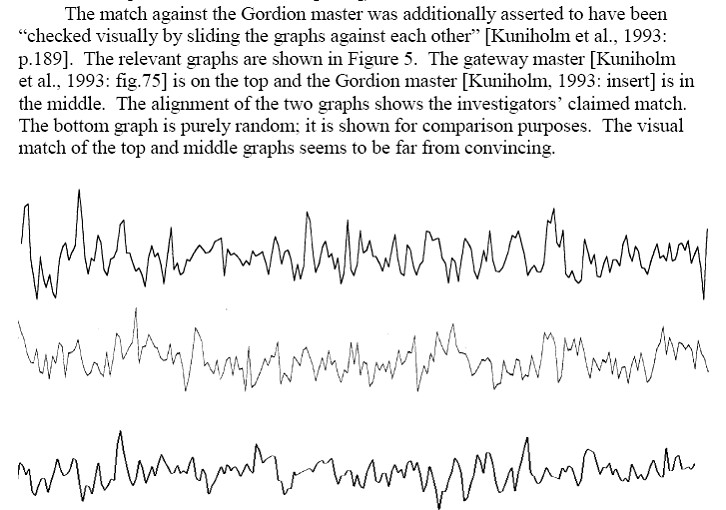
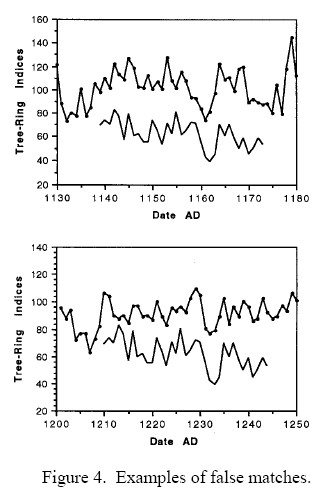 Turkish
dendrochronology is quite interesting and relevant to this discussion and the
understanding of the science of dendrochronology as a whole. One especially
interesting example has to do with the work of Kuniholm and his dating of wood
from the city gateway at Tille
Höyük
- an ancient city. What happened was that the t-value wiggle-match produced by
computer analysis came up with not one, but three matches of 1258, 1140, and 981
B.C. - each with a greater than 99.9% certainty.19 Notice the
figure detailing false matches from Tille
Höyük at right. Also notice the alignment of the
Tille
Höyük
sequence with the Gordion master sequence (figure above) and with a completely
random sequence. Which one has a closer match? It all seems rather subjective
does it not? - and this is done with computer assistance.
Turkish
dendrochronology is quite interesting and relevant to this discussion and the
understanding of the science of dendrochronology as a whole. One especially
interesting example has to do with the work of Kuniholm and his dating of wood
from the city gateway at Tille
Höyük
- an ancient city. What happened was that the t-value wiggle-match produced by
computer analysis came up with not one, but three matches of 1258, 1140, and 981
B.C. - each with a greater than 99.9% certainty.19 Notice the
figure detailing false matches from Tille
Höyük at right. Also notice the alignment of the
Tille
Höyük
sequence with the Gordion master sequence (figure above) and with a completely
random sequence. Which one has a closer match? It all seems rather subjective
does it not? - and this is done with computer assistance.
Consider what happens when computers aren't used to judge the statistical value of a "match". A "visual match" (see figure below) was published in 1998 (Wiener, 1998, p. 314) dealing with wood from a ancient shipwreck that was dated against the Gordion Master via visual matching alone. This match was published by both Kuniholm and Manning. In 1999, a letter was sent to various e-mail lists, and also to the principal investigator in Anatolian tree-ring studies, pointing out some of the problems already listed (especially the statistical aspects) and concluding that there was no tree-ring match for the shipwreck wood [James, 1999]. Two years later, in the next major paper in Anatolian tree-ring studies, the tree-ring date for the shipwreck was acknowledged to be “not especially strong†[Manning et al., 2001: n.38].20
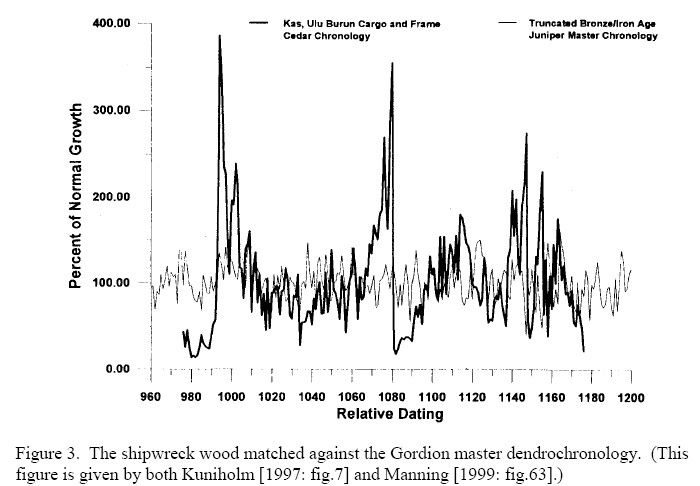
Consider that perhaps desire plays more of a part than actual detached science when it comes to dendrochronology. In this light, note that dendrochronologists working in Hohenheim, Germany, were proven wrong three times in the mid 1990s, each time after very strong assertions of reliability.20
Another problem is that wood with less than about 100 rings is notoriously poor when it comes to statistical matches with tree ring comparisons. It is most interesting then that the Bronze Age gateway at the Tille Höyük (mentioned above) was constructed with the use of many trees with few rings. Of the many specimens that were available, 26 were matched against each other to form a master sequence. The problem is that among the 26 specimens in this master chronology, 6 had fewer than 40 rings and 21 specimens had fewer than 60 rings. Only two had more than 100 rings and their overlap comprised only 33 rings. Despite this master being much acclaimed, its reliability is significantly flawed - so much so that it is statistically "worthless" as a master sequence.20 Douglas Keenan laments:
"The central conclusion is clear: Anatolian tree-ring studies are very untrustworthy and the problems with the work should be plain to anyone who has familiarity with the field. This is a serious matter. Consider that the work has been published in respected research journals and been ongoing for many years. How could this have happened?"20
Changing climatic conditions also seems to play havoc with the reliability of tree ring matching. "For example, master dendrochronologies for Scotland and Northern Ireland match extremely well during 1800–1899 (t-scores indicate 99.999999999999999999% confidence), but much less well during 1700–1799 (t-scores indicate 99.996% confidence) [Baillie, 1982: p.109]. Similarly, master dendrochronologies for Exeter and Nantwich (both in England, about 275 km apart) match acceptably during AD 1061-1216 (t-scores indicate 99.999% confidence), but hardly at all during AD 930-1060 (t-scores indicate 60% confidence—i.e. roughly the same as flipping a coin) [Hillam,1980]. This second example, in particular, illustrates the danger that a changing climate can pose for tree-ring matching." 20
Another interesting experiment was performed by LaMarche (1974). LaMarche measured living trees on two sites in Nevada, both on the same side of the same mountain. One site was just 130 meters higher in elevation than the other, near the tree line. The ring widths of the trees from the two sites showed no general correlation whatsoever. Hillam (1980) also compared master dendrochronologies from two sites at York, England, with a master dendrochronology from Exeter, also in England. One York site showed an Exeter t-score wiggle-match of only 0.5 while the second York site returned a t-score of 3.5. Why such a marked difference? What does this say about the statistical significance of such "matches"? 20
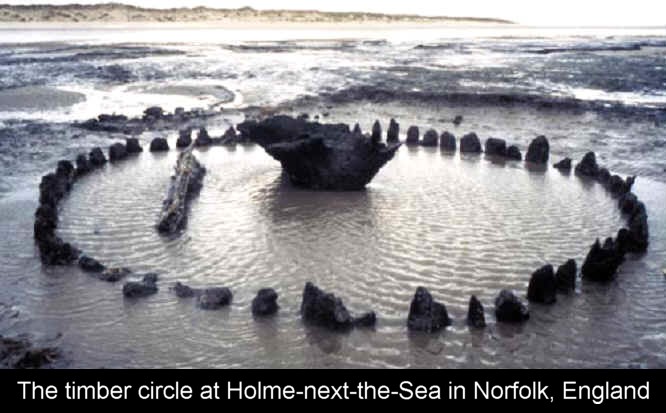
Consider also the timber circle discovered at Holme, England. Discovered in 1998, this circle consists of 55 inverted oak trees. A 168-year ring chronology was created and this chronology was compared with not one, but several master tree ring chronologies. In an article published in a 1999 issue of Nature, the authors comment:
"This tree-ring sequence was compared with a series of reference chronologies. The highest . . . correlation was against the East Anglia chronology (t-3.98; higher t-values are more significant), giving an end date for the site chronology of 2050 BC. It also produced lower correlations against East Anglia ending at 2454 BC (t-3.17) and 2019 BC (t-3.14). Running the ring pattern against the Irish master gave correlations of t-3.39 at 2050 BC, but only t-0.96 at 2454 BC and t-1.7 at 2019 BC."24
Why the significant difference in matches depending on which master was chosen? In the same article, the authors go on to note that radiocarbon dating of these same trees show a statistical accuracy of agreement of only 26.7%. The authors explain that, "Interlaboratory offsets, errors and regional variation in the radiocarbon content of the atmosphere may be significant when producing precise archaeological chronologies."24 If this is true, exactly how "precise" can one be when producing theories based on dendrochronology or even radiocarbon dating?
And, as previously mentioned, the investigators themselves have not been subjected to the normal rigors of scientific investigation. In this line, consider the follow scathing commentary, by Douglas J. Keenan, on the sorry state of dendrochronology at the present time:
"In almost all branches of science, other than tree-ring studies, there is a check on the validity of published research: other researchers can, and often will, independently seek to replicate the research. For example, if a scientist does an experiment in a laboratory, comes to some interesting conclusion, and publishes this, then another scientist will replicate the experiment, in another laboratory, and if the conclusion is not the same, there will be some investigation.
The result is (i) a scientist who publishes bogus research will be caught (at least if the research has importance and is not extremely expensive to replicate) and (ii) because all scientists know this, bogus science is rare. Tree-ring studies do not have this check, because the wood that forms the basis of a tree-ring study is irreplaceable: no other researchers can gather that wood.
Additionally, tree-ring investigators typically publish little more than conclusions. This is true everywhere, not just for Anatolia. Moreover, there is little competition among tree-ring investigators, in part—and this is crucial—because investigators in one region typically do not have access to data from other regions. The result is a system in which investigators can claim any plausible results and yet are accountable to no one." 20
Kuniholm himself made the following observations about the state of the "science" of dendrochronology at the present time:
"I, for one, was quite surprised to learn that dendrochronological data … is considered highly proprietary. … The value … of the … dendrochronological database is vitiated if there are no data attached and therefore available for use by others…. We must keep in mind that unpublished information is next to worthless." 20,21
Consider also the frustration of Rod A. Savidge Ph.D. Savidge is a professor of tree physiology/biochemistry, Forestry, and Environmental Management at the University of New Brunswick. He vented the following interesting comments regarding the science of dendrochronology, published in a Letter to the Editor in the New York Times, November of 2002:
"As a tree physiologist who has devoted his career to understanding how trees make wood, I have made sufficient observations on tree rings and cambial growth to know that dendrochronology is not at all an exact science. Indeed, its activities include subjective interpretations of what does and what does not constitute an annual ring, statistical manipulation of data to fulfill subjective expectations, and discarding of perfectly good data sets when they contradict other data sets that have already been accepted. Such massaging of data cannot by any stretch of the imagination be considered science; it merely demonstrates a total lack of rigor attending so-called dendrochronology "research" . . . It would be a major step forward if dendrochronology could embrace the scientific method." 25
I personally find it most interesting that tree-ring specialists do not and historically have not actually subjected their judgments to potential falsification - to include Ferguson. For example, while Ferguson was still alive, he never allowed anyone to analyze his original data or the basis for the many suppositions that went into the establishment of his chronology. So, Ferguson's chronologies were not subjected to the normal rigors of science and thus should not be accepted as scientifically credible. Surprisingly, modern dendrochronologists are not all that much better about revealing their data either.10
Beyond this, even where dendrochronology is accepted as reliable, there are problems. For example, there seems to be close agreement between the standard decay curve of carbon 14 and the dendro-calibration for the last 2,500 years. However, around 500 B.C. the two curves begin to diverge so that by 4,000 years before present (BP) the gap is 250 years and by 7,000 BP the gap is 630 years. In addition, consider the question that if carbon 14 dating is calibrated by tree ring analysis could carbon 14 be used to validate tree ring analysis? This would be a form of circular reasoning – right? And yet this very thing is done all the time. Whenever there is a discrepancy in building a dendrochronological sequence, carbon 14 is used to choose the "correct" match. Sometimes this "correct" match is not the best statistical match, but it is chosen anyway because it has the best agreement with the established paradigm of the day. 22
Other Calibration Methods
As discussed elsewhere on this website, other calibration methods also have problems when it comes to the carbon 14 dating of specimens older than 4 or 5 thousand years. Most of the problem with these methods is that there is no standard rate at which layers form; be they lake varves, ice-core layering, coral colonies, tree rings etc. None of these is consistent. Many lake varves can form even in one day, not to mention one year. Many snowstorms or warm and cold spells can happen in a given season and make many layers, or few layers per year. Not only is carbon 14 dating limited in its theorectical usefulness any farther back in time than 50,000 years,3 but its dating accuracy seems to be in question for anything greater 4 or 5 thousand years. This is possibly do to the fact that the 14C atmospheric concentration (relative to 12C) is rising and is not the same as it was only a few thousand years ago.
A Sudden Historical Decrease in Carbon-12
Now, suppose there had been a major atmospheric disturbance, such as the one described in the flood "myths" of many diverse cultures about 5,000 years ago. If true, might such a global catastrophe be expected to alter the 14C to 12C ratio just a little bit? Perhaps, but by how much and would this really be significant?
Consider, for argument's sake, what would happen to the carbon-14 dating assumptions if there was a significantly greater quantity of carbon 12 in the biosphere of this earth sometime in the recent past. What would happen to the 14C to 12C ratio? It would be reduced - right? This reduction in the 14C to 12C ratio would give an increased apparent age to start out with, relative to our present day 14C to 12C ratio.
Now, what happens if the geologic column and the fossil record really are records of truly catastrophic processes? As it turns out, there are around 39 trillion metric tons of carbon in the biosphere. However, there are around 6,820 trillion metric tons of carbon currently buried in the form of coal, oil, and fossils. This is about 175 times the amount of organic matter than we have living today. Also, some of the buried carbonates could have been part of the biosphere at some point in time. Sedimentary carbonates are a huge block of carbon to consider, as much as 20,000 trillion metric tons of sedimentary carbonates are found in the geologic column.17
What if these huge coal and oil beds, not to mention the huge quantities of calcium carbonate, were buried rapidly in some catastrophic calamity? Wouldn't this mean that all of this organic material was all living at or near the same time and that the carbon used to make this organic material was also part of the living biosphere at about the same time? If true, the amount of carbon 12 in and available to the biosphere was significantly greater in the past than it is today. In fact, without even considering the carbon in the vast quantities of calcium carbonate, there is enough carbon 12 buried in the fossil coal, oil, and other fossils to reduce the apparent ratio of 14C to 12C by about 7 half-lives.17
Unless the production of carbon-14 was equally greater in the past (either via markedly increased nitrogen 14 and/or radiation), such a huge increase in carbon-12 would dramatically lower the ratio of 14C vs. 12C (equivalent to about 7 half lives). Obviously then, this would completely throw off the whole basis of carbon-14 dating going farther back in time beyond such a catastrophic event or closely spaced events. Certainly then, carbon-14 could not be used to rule out the recent occurrence of such a global catastrophe.
Given such a global catastrophe that removed huge quantities of carbon-12 from the biosphere, a rapid increase in the 14C to 12C ratio would certainly follow. Consider that if an animal or plant lived during this time of rapidly increasing carbon-14 levels (relative to carbon-12) that different portions of the plant or animal would have different 14C to 12C ratios incorporated into these different parts depending upon the rate of growth. Those areas of the animal or plant that grow faster would exhibit higher levels of carbon-14 over time as compared to those parts of the animal or plant that grow more slowly or have stopped growing altogether (as in the case of tree rings). For example, hair grows fast, so we might expect to see higher levels of carbon-14 in hair as compared to slow growing bone, muscle, or brain tissue. In light of this, consider that different parts of well preserved creatures or other surrounding organic materials have returned very different carbon-14 dates. For example, the scalp muscle tissue of the "Fairbanks Creek Musk Ox" was carbon-14 dated to be 24,000 years old while the hair of this ox was carbon 14 dated at 17,000 years old.17 Also, consider the following quotation from the journal Science concerning the increasing levels of carbon-14 in bristlecone pine trees.
From the "Symposium Organized By International Atomic Energy Authority", H. E. Suess, UCLA, "...presented the latest determinations... as adduced from the current activity of dendrochronologically dated growth rings of the Californian bristle cone pine....The carbon14 concentration increases rather steadily during this time… These results confirm the change in carbon14 concentration.... and indicate that the concentration increases..." (Science, Vol.157, p.726)
There is also what is called a "reservoir effect" where significant variations of the ratio of present day 14C to 12C are recognized (as compared to the average ratio in the overall biosphere). Since the oceans have lower levels of carbon 14 compared to the atmosphere, most living marine creatures date at least several hundred years old. Also, because of local thermal vents that spew out large quantities of carbon-12, certain aquatic mosses living in Iceland date as old as 6,000 to 8,000 years via the carbon-14 dating method. And, in Nevada, living snails have apparent carbon-14 ages up to 27,000 years old. Marine shells in Hawaii show younger dates if preserved in volcanic ash vs. limestone. 17 Also, research has shown the ancient peat reveals an marked decrease in carbon-14 ratios at lower and lower levels (i.e., decreased carbon-14 with older age well beyond what would be expected with radioactive decay).17
Carbon-14 in Coal and Oil
There is yet another very interesting problem with 14C dating. Significant amounts of carbon-14 have been detected in specimens previously thought to be millions of years old, to include coal, oil, and even carboniferous portions of fossils belonging to dinosaurs etc. Of course this would seem to be impossible because of the fact that carbon-14 in any amount cannot theoretically exist beyond 75,000 to at most 100,000 years. These ancient fossils should have no carbon-14 remaining at all. When tested for carbon-14 they should yield an "infinite" age but they do not because they do in fact have carbon-14 remaining. What is the explanation of this phenomenon?
Such claims for carbon 14 found in organic material dating in the millions of years are in fact quite common. Coal is supposed to have formed millions of years ago, and yet all coal has fair amounts of carbon-14. 12 Fossil wood found in "Upper Permian" rock that is supposedly 250 Ma old still contained significant amounts of carbon-14. 13 Recently, a sample of wood found in rock classified as "middle Triassic," supposedly some 230 million years old, gave a carbon-14 date of around 33,720 years.14 The accompanying checks showed that the 14C date was not due to contamination of "modern" carbon-14. Of course, despite the great care taken to avoid contamination, significant levels of carbon-14, when found in fossils supposed to be millions of years old, are still attributed to contamination, background noise, or even production of carbon-14 by the radioactive decay of other closely associated radioactive elements. It is thought that one or all of these processes explain the fact that trace amounts of carbon-14 are expected in all ancient organic material. These effects seems to limit carbon-14 dates of all organic specimens to less than 43,000 years.15

It is also very interesting that carbon-14 is being found in the soft tissues of dinosaur bones in significant quantities.
A team of researchers gave a presentation at the 2012 Western Pacific Geophysics Meeting in Singapore, August 13-17, at which they gave 14C dating results from many bone samples from eight dinosaur specimens. All gave dates ranging from 22,000 to 39,000 years, right in the 'ballpark' predicted by creationists.
It appears that the researchers approached the matter with considerable professionalism, including taking great pains to eliminate contamination with modern carbon as a source of the 14C signal in the bones. The lead presenter was Dr Thomas Seiler, a German physicist whose PhD is from the Technical University of Munich. This video presentation was up on YouTube at the time of writing this report (Link).
Two of the report's physicist co-authors, Professor Dr Robert Bennett and Dr Jean de Pontcharra, till recently with the French Atomic Energy Commission's Grenoble Research Centre, are urging colleagues to do their own carbon dating of dinosaur bones. They say that the media should be encouraging scientists to do this also, presenting the findings openly and honestly at similar conferences. This would certainly be in the interests of scientific truth - especially following the repeated findings of soft tissue in dinosaur bones, and now even seemingly irrefutable DNA in dinosaur specimens. The public has the right to know the actual chronology of the dinosaurs, and indeed the history of the earth. 26
The Contamination Argument
In testing the Tandem Accelerator Mass Spectrometer (TAMS), a major problem appeared. Normally as in any test with decay counting, background counts must be made. Usually, fossil carbon is used for the background count since it is assumed that the fossil carbon is anywhere between 60 and 600 million years old and therefore cannot possibly have any 14C left. However, as previously noted, fairly high levels of carbon 14 are in fact present in these samples. R.H. Brown reported in Origins 1988(15), p. 39-43 that "infinite age" samples of fossil carbon are being reported in the literature as having C-14 ages in the 40,000-year range. The laboratories doing this research are from Europe, Canada, and the USA (Brown et al. 1983; Jull et al. 1986; Beukens, Gurfinkel, and Lee 1986; Grootes et al. 1986; and Bonani et al. 1986).
"Contamination from our present Biosphere" was the most widely used interpretation to explain the presence of these "unexpected results". The journal Radiocarbon (Vol. 29, No. 3, 1987) contains two different reports from groups that attempted to explore the limits of this "contamination". The first group, from Simon Frazer University in British Columbia (Vogel, Nelson and Southon 1987) measured 43 samples of anthracite (coal) from Pennsylvania, USA, that had been given the best known pretreatment to remove contamination by modern carbon. The sizes of the samples ranged from 0.5 to 20 milligrams. They all yielded around 43,000-year carbon 14 dates, regardless of the sample size. Again this finding was attributed to machine background and contamination during sample preparation. The second group, from the University of Toronto in Ontario (Gurfinkel 1987) stated that "One of the major problems encountered in this study was the apparent presence of 14C contamination in samples that were assumed dead . . . it could not be assumed that even the oldest samples were necessarily 14C free" (p. 342). Gurfinkel, went through a meticulous process using graphite, calcite, limestone and anthracite samples to come up with her conclusions. And, all she could say is that "infinite age" samples should be expected to have "contamination" giving dates as recent as 43,000 years, which is similar to what the Simon Frazer University group obtained. As more and more groups looked at this problem, it has become common knowledge that there is a wall this side of about 50,000 14C years that cannot be passed in practice.
Now, consider that if the "background noise" was really a problem that even if no sample was in the detection machine that the machine would still report background noise corresponding to ages less than 50,000 years. This is not what happens. According to Schmidt et. al., no counts were detected in 30 minutes giving an age greater than 90,000 years.18 Geological graphite was also tested and gave an carbon 14 age of almost 70,000 years. Compare this with "infinite age" samples of fossil coal, oil, bone, ect., that all date less than 50,000 years.17 Certainly background noise cannot explain such a discrepancy. So, what about other sources of actual contamination?
The theory of the de novo production of carbon 14 by surrounding radiation is presented as one source of possible carbon 14 formation/contamination. However, to explain the current rather high levels of 14C in coal, oil, and other ancient carboniferous fossils, the amount of surrounding radioactivity must have been much greater in the past. For example, lets say we have a 10 million year old specimen with enough 14C in it to give it an apparent age of 40,000 years. In order for this level of 14C to be the result of surrounding radioactivity the initial level of radioactivity 10 million years ago had to be far above lethal levels (high enough to glow like a light bulb).16 Also, such sources of surrounding radiation had to be very widely present throughout the entire geologic column since all samples of coal, oil, and other organic fossils show approximately the same rather high levels of carbon 14. This level of contamination would be hard enough to believe with oil and gas, but would be extremely incredible with coal since many coal seams are hundreds of feet thick and very pure without evident radiogenic contamination significant enough to explain the high carbon 14 levels generally found in coal fields all over the globe. Clearly there is a problem here.
The common explanations given simply do not explain the obviously high levels of 14C in supposedly ancient organic specimens to my own satisfaction. These specimens often come from deep in the earth in areas that are effectively shielded from environmental carbon interaction or contamination. Without the possibility of carbon exchange with the external environment, how could such specimens be contaminated? It seems practically impossible for contamination of all such specimens to have occurred, and yet they all show that relatively high levels of 14C remain. And yet, for scientists studying this problem, the answer must be contamination because obviously these fossils are millions of years old. But, what if the fossils are not millions of years old? What if they died recently and were buried recently? What theory is most consistent with the evidence?
Unfortunate Creationist Misquotes or Misleading Statements
"Coal from Russia (the "Pennsylvanian)" supposedly 300 million years old, was dated at 1,680 years." 7
The original article in the journal Radiocarbon includes the following paragraph describing this sample:
MMo-334. River Naryn, Kirgizia 1680 ± 170. A.D. 270
Coal from the cultural layer on the left side of the r. Naryn (Kirgizian SSR), 3 km E of the mourh of the r. Alabuga (41° 25′ N Lat, 74° 40′ E Long). The sample was found at a depth of 7.6 m in the form of scattered coals in a loamy rock in deposits of a 26-m terrace. According to the archaeological estimations the sample dates from the 5 to 7th centuries A.D. The sample was found by K. V. Kurdyumov (Moscow State Univ.) in 1962. Comment:/i> the find serves as a verification of archaeological data on the peopling of the Tien Shan.7
What we have here is no more than shorthand or sloppy translation from the Russian! The coal is nothing more than charcoal from an archaeological deposit. This sample is even included in the section of the report dealing with archaeological samples, and the paragraph discusses archaeological data.
The odd use of terms is shown clearly in another radiocarbon date, Mo-353, reported on page 315 of the same article. It reads "Charcoal from cultural deposits of a fisher site. The coal was coll. from subturfic humified loam"
But the term "coal" in place of "charcoal" was enough to fool Ken Ham, as well as dozens of subsequent creationists who apparently were salivating to find 300 million year old coal radiocarbon dated to recent times, and who repeated Ham's false claim without bothering to check its accuracy.
The interesting question is where Ken Ham managed to find "Pennsylvanian" in that short paragraph, and where he dug up the date of 300 million years. 5 (Quoted from Darwin Central: Link)
"Natural gas from Alabama and Mississippi (Cretaceous and Eocene, respectively) should have been 50 million to 135 million years old, yet 14C gave dates of 30,000 to 34,000 years, respectively." 7
Dr. Aardsma investigated this claim also, and noted:
The original reference [Trautman and Willis, page 200.] in the second case (natural gas) immediately reveals that both Whitelaw and The Answers Book have, unfortunately, neglected several very important ">" or "greater than" signs. The "dates" in this case are given in the original publication as ">30,000" and ">34,000". Thus, these natural gas samples were not dated to "30,000 to 34,000 years" at all. In fact, the original reference plainly notes "infinite age as expected". (Aardsma, 1994, page 2.)
The sensitivity of the equipment used to make the radiocarbon measurements on these natural gas samples was limited to 30,000 to 34,000 years---the equipment was unable to measure back further. Here again the radiocarbon dates were as expected. (For additional discussion see the Biblical Chronologist.org: Link)
"Bones of a saber-toothed tiger from the La Brea tar pits (near Los Angeles), supposedly 100,000 to one million years old, gave dates as recent as 28,000 years." 8
This is another common creationist mistake. The accepted age for the La Brea Tar Pits is from about 9,000 years to about 50,000 years. The "supposedly 100,000 to one million years" is way off base. (For further discussion see the Free Republic: Link)
"Eleven human skeletons, the earliest known human remains in the western hemisphere [Dated by amino acid dating at ~48,000 years BP] have been dated by the "accelerator mass spectrometer" technique. All eleven were dated at about 5,000 radiocarbon years or less." 1
These skeletons were all originally dated by the amino acid racemization method, which has been shown to be extremely inaccurate. The radiocarbon dates straightened out the dating error in the amino acid racemization method. This is just the opposite of what the article implies. (For further discussion see the Free Republic: Link)
Other Interesting Questions
Currently Radiocarbon is forming 28-37% faster than it is decaying. 2
The last major glacial advance in America was believed by most scientists to have occurred about 25,000 years ago. Carbon 14 dates forced a revision down to 11,400 years. The United State Geological Survey carried out studies that gave a 14C date as recent as 3,300 years ago, but no textbook deals with such a puzzling find that falls well within recent history. 6 Here is a remarkable example of 14C difficulties in a book published by Stanford University Press. Six 14C ages were determined from a core in an attempt to date the formation of the Bering Land Bridge. The dates ranged from 4,390 to 15,500 years old.6
Carbon 14 analysis of oil from Gulf of Mexico deposits showed an age measured in thousands of years - not millions. Data produced by the Petroleum Institute at Victoria, New Zealand, showed that these petroleum deposits were formed 6,000-7,000 years ago even though it is commonly believed that all such petroleum formations took place about 60 to 300 million years ago.4
In August of 1994, pieces of wood were obtained from an Australian mining company (BHP Australia Coal Pty Ltd, operators of the Crinum Mine). The wood was found while drilling through a basalt layer. The wood was sent to two separate laboratories for 14C testing (Geochron Laboratories in Cambridge, Boston (USA), and the Antares Mass Spectrometry laboratory at the Australian Nuclear Science and Technology Organisation (ANSTO), Lucas Heights near Sydney (Australia). Geochron returned a date of 35,000yrs and ANSTO returned a date of 44,000yrs. The Basalt, which was in contact with the wood, was also sent to two laboratories (Geochron and AMDEL) for K-Ar/Ar-Ar dating. The youngest age given among four samples was over 36 million years.9
R. E. Taylor, Major Revisions in the
Pleistocene Age Assignments for North American Human Skeletons by C-14
Accelerator Mass Spectrometry, American Antiquity , Vol. 50, No. 1,
1985, pp. 136-140.
Melvin A. Cook, Nonequilibrium
RadioCarbon Dating Substantiated, Vol. 2 (Pittsburgh, Pennsylvania:
Creation Science Fellowship, 1986), pp. 59-68.
Robert E. Lee, Radiocarbon: Ages in
Error, September 1982, pp. 116-117.
Velikovsky, 1955, p.287; CRSQ , 1965, 2:4, p.10.
Darwin Central, Reference posted on Saturday, June 16th, 2007 at 4:52 PM by Bones in Commentary (Link)
Velikovsky, 1955, p.158-159; CRSQ , 1968, 5:2, p.67
Vinogradov, A.P.; A.L. Devirts; E.I. Dobinka; and N.G. Markova. Radiocarbon dating in the Vernadsky Institute I-IV. Radiocarbon, Vol 8, No. 1, 1966, pp. 292-323.
Radiocarbon, vol. 10, 1968.
Andrew Snelling, First published in:
Creation Ex Nihilo 20(1):24-27 December 1997 – February 1998.
Ferguson CW. 1969. A 7,104-year
annual tree ring chronology for bristlecone pine, Pinus aristata,
from the White Mountains, California. Tree-Ring Bulletin 29(3-4):3-29.
D.C. Lowe, "Problems Associated with the Use of Coal as a Source of 14C Free Background Material," Radiocarbon, 1989, 31:117-120.
Snelling A.A., Stumping Old-age Dogma. Creation, 1998, 20(4):48-50.
Snelling A.A., ‘Dating Dilemma,’ Creation, 1999, 21(3):39-41.
Vogel, Nelson and Southon, Radiocarbon, Vol. 29, No. 3, 1987
Giem PAL. 1997b. Carbon-14 dating methods and experimental implications. Origins 24:50-64.
Mike Brown, ( http://www.creation-science-prophecy.com/C14c.htm ) June, 2001
Schmidt et al. Nucl Instr and Meth 1987;B29:97-9 (Quoted by Paul A. L. Giem Scientific Theology, La Sierra University Press Riverside, 1997)
Kuniholm, P. -- 1993: Appendix in G. Summers: Tille Huyuk 4, pp. 179-90
Douglas J. Keenan, Anatolian tree-ring studies are untrustworthy, The Limehouse Cut, London E14 6N, United Kingdom; doug.keenan@informath.org, 16 March 2004 ( http://www.informath.org/ATSU04a.pdf ) See also: Douglas Keenan, Why Radiocarbon Dates Downwind from the Mediterranean are too Early, Radiocarbon, Vol 44, Nr 1, 2002, p 225–237 ( http://www.informath.org/14C02a.pdf )
Kuniholm P.I. (2002), "Archaeological dendrochronology", Dendrochronologia 20: 63–68.
Allen Roy, C14-Dendrochronology ( allen@infomagic.com ) Sun, 2 May 1999 21:09:50 -0700 ( http://www.asa3.org/archive/asa/199905/0017.html )
Lammerts, Walter E. Are the Bristlecone Pine Trees Really So Old?, Creation Research Society Quarterly, 20:108-115, September, 1983.
NATURE | VOL 402 | 2 DECEMBER 1999 | www.nature.com
Rod A. Savidge, Letter to the Editor, New York Times, November 12, 2002; In response to an article by Claudia Dreifus, A Writer Leaves History Behind to Celebrate Trees: A Conversation with Tom Pekenham, New York Times, November 12, 2002 ( Link1; Link 2 )
Carl Wieland, Radiocarbon in dino bones - International conference result censored, Creation Ministries International, 22 January 2013 (Link)
. Home Page . Truth, the Scientific Method, and Evolution
.
. Maquiziliducks - The Language of Evolution . Defining Evolution
.
.
Evolving the Irreducible
.
.
.
.
.
. DNA Mutation Rates . Donkeys, Horses, Mules and Evolution
.
.
. Amino Acid Racemization Dating . The Steppingstone Problem
.
.
. Harlen Bretz . Milankovitch Cycles
.font> Kenneth Miller's Best Arguments
Since June 1, 2002